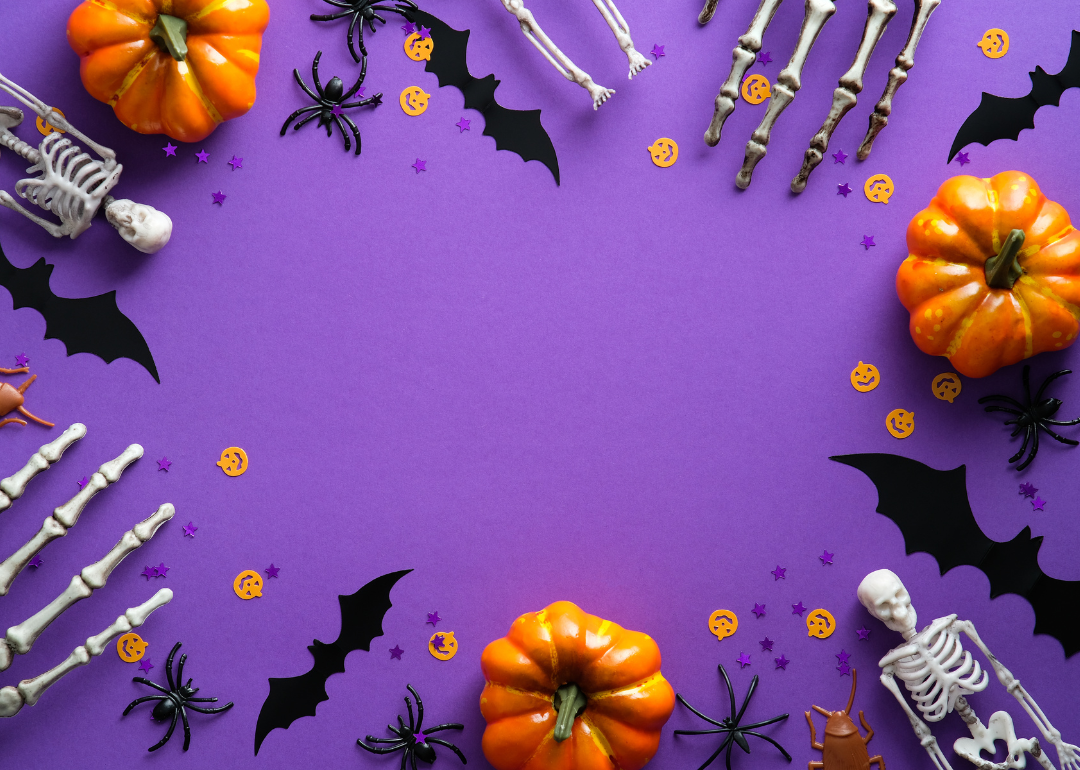
Scare up some Halloween savings with these money-saving tips
Scare up some Halloween savings with these money-saving tips
If you aren't watching prices carefully when buying treats this Halloween, you could be left feeling tricked.
Anyone with a wallet knows that inflation has been abnormally high lately. In fact, according to the Bureau of Labor Statistics, when consumer prices increased 9.1% from June 2021 to June 2022, it was the largest increase in costs in 40 years. That was the peak, and while prices have come down a little since then, Americans are still grappling with higher costs. In September 2023, for instance, the price of everything — shelter, food, medical care and so on — was 3.7% higher than it was in September 2022.
So, where does the cost of Halloween come into all of this? MoneyGeek analyzed Halloween candy, costume, and decor prices from 2021 and 2022 to understand how much more expensive everybody's favorite spooky holiday will be this year amidst increasing costs.
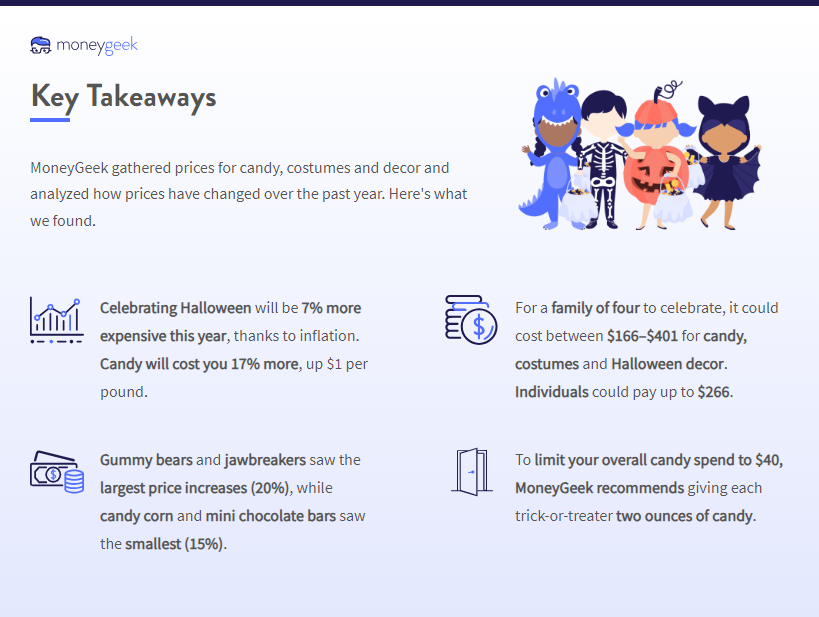
All around, Halloween is pricier this year than last
MoneyGeek analyzed the cost of costumes, candy and Halloween decorations currently being sold in stores across the United States and compared them to 2021 prices to learn how inflation has impacted these items.
Above are some of the key findings from that analysis.
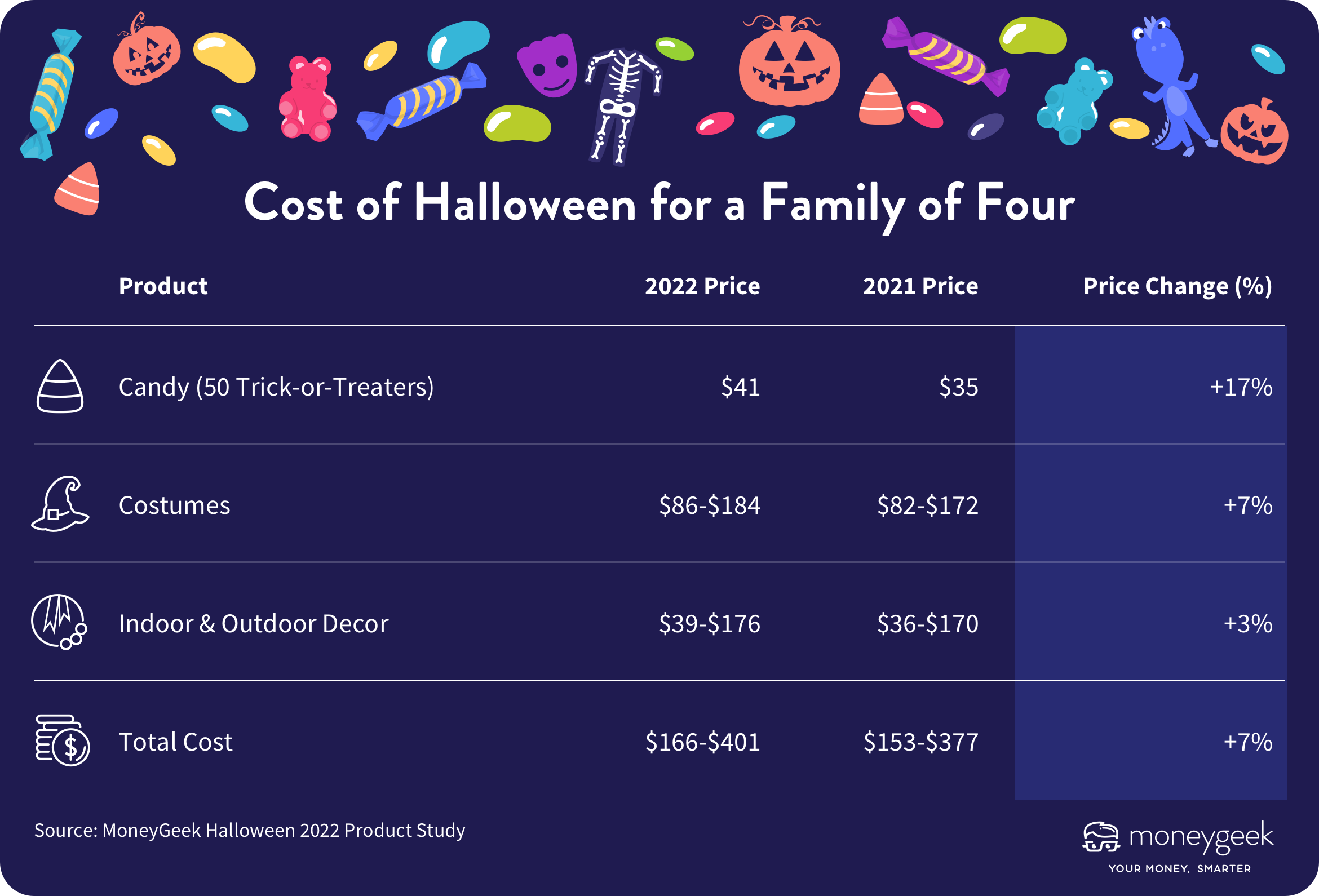
Which aspects of Halloween have become more expensive? All of them
Perhaps not surprisingly, costumes are the most expensive Halloween tradition. In 2022, the average family of four will spend between $86 and $184 on them. Candy had the highest percentage increase in inflation (17%), while Halloween decor had the lowest (3%).
All of these expenses add up. If you're single and without kids, you can expect to pay around $266 if you are serving trick-or-treaters, purchasing a costume and decorating your home for the season, which is 7% more than you would have spent the year before.
The National Retail Federation reports that the number of consumers planning to participate in Halloween-related activities is consistent with pre-pandemic levels. However, planned spending is slightly down from 2021, when consumers expected to spend $103 per person; in 2022, the average consumer plans to spend $100.
However, what consumers hope to pay to celebrate Halloween and what they actually pay may end up being far different. MoneyGeek's projections are significantly more expensive than what consumers believe they'll pay, likely because of the higher costs of in-store prices for candy and costumes and the popularity of Halloween home decor.
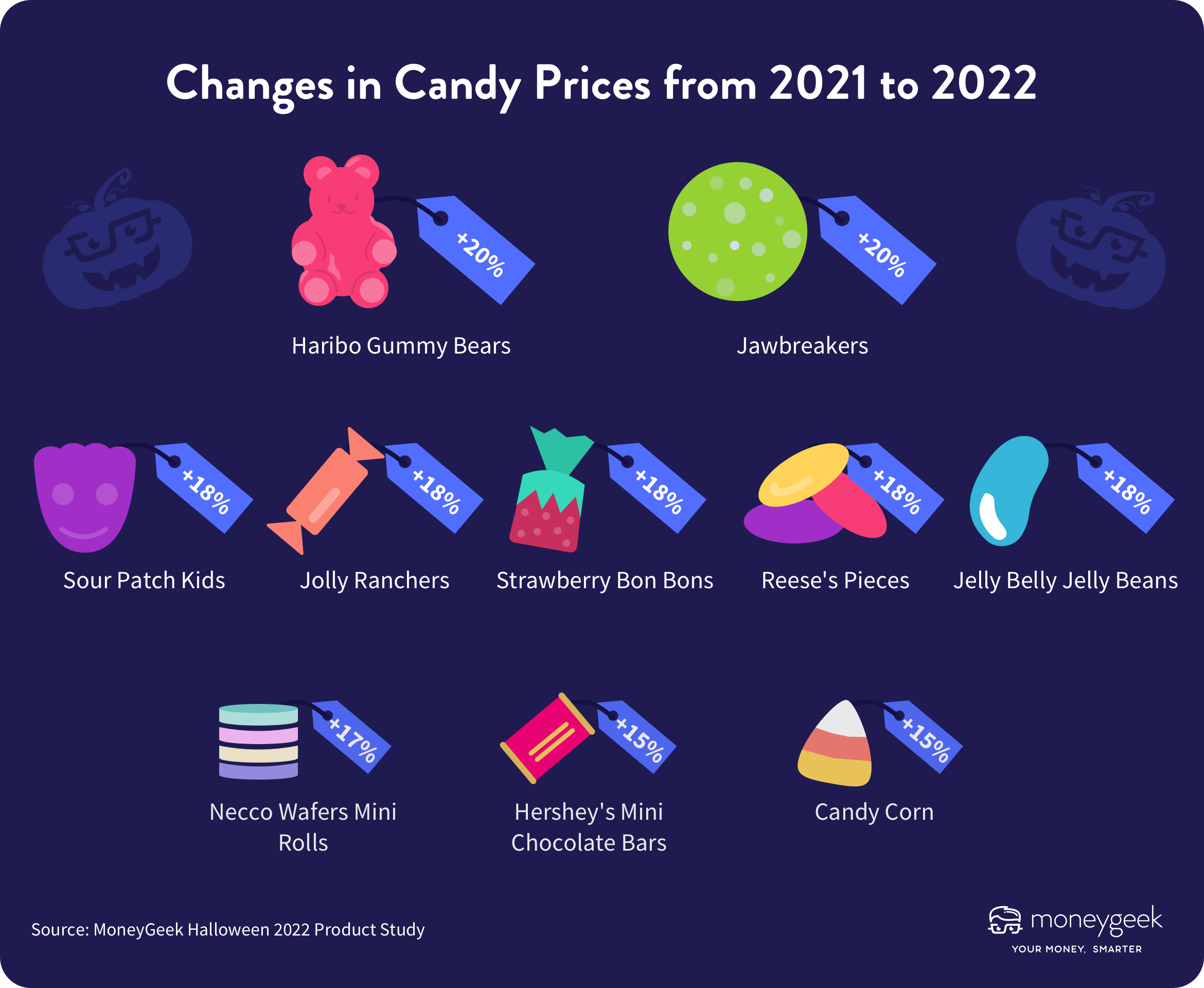
Candy inflation analyzed
At 17%, inflation has hit the candy counter harder than any other Halloween category; this percentage far surpasses inflation rates for costumes and decor, which were 7% and 3%, respectively.
However, the price of candy didn't increase uniformly. Our analysis found that you'll pay more if you give out Haribo Gummy Bears or Jawbreakers — prices for both are 20% higher now than last year.
But while your jaw may drop at the cost of Jawbreakers, prices for other types of candy haven't increased as much. For instance, Jolly Ranchers and Reese's Pieces are 18% more expensive than last year. We found that Hershey's Mini Chocolate Bars and Candy Corn had the smallest price increase from 2021 to 2022; those both went up 15%.
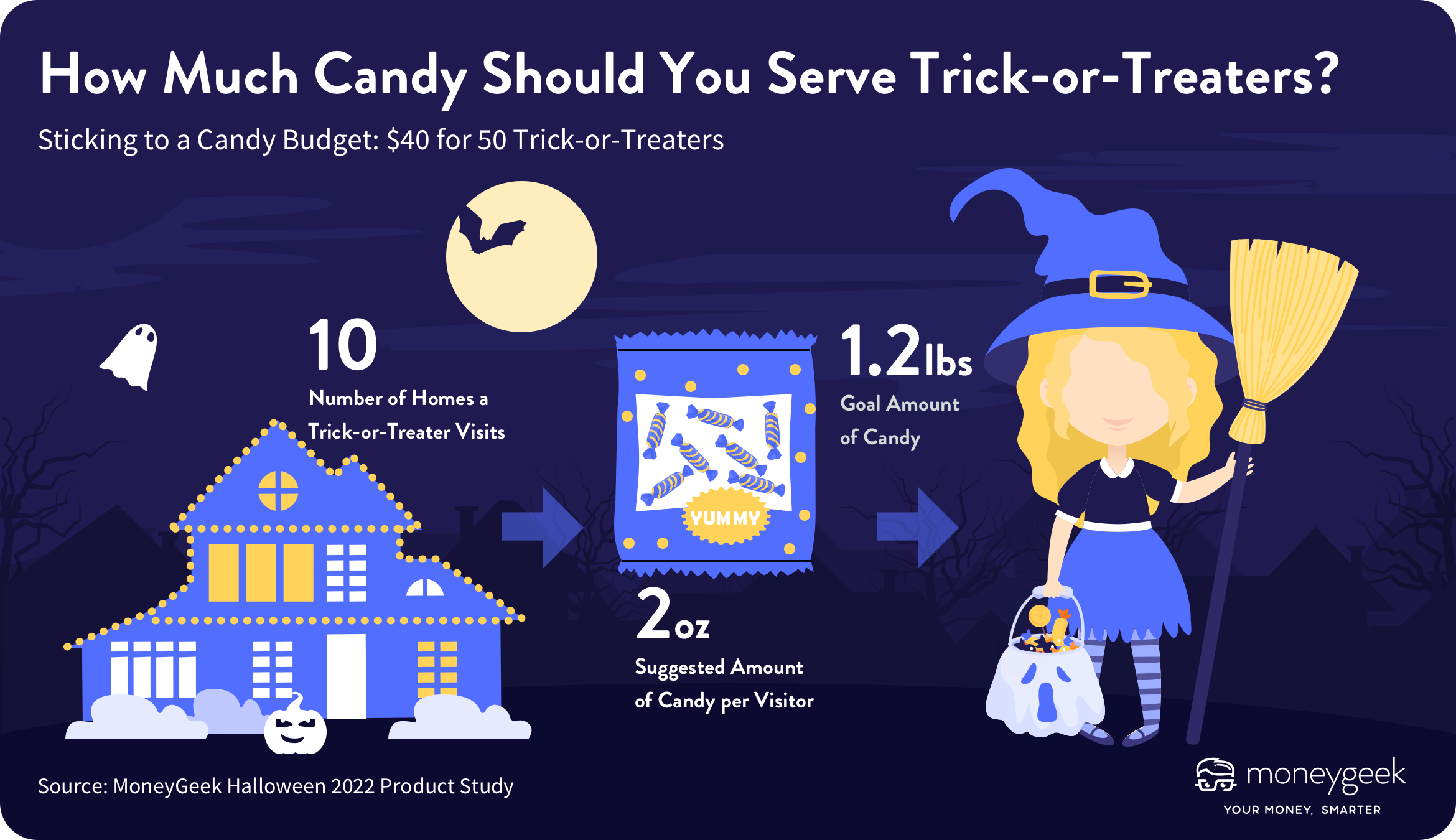
How much candy should you serve trick-or-treaters?
If the average trick-or-treater consumes 1.2 lbs of candy on Halloween — a figure calculated by the Mayo Clinic — and visits 10 homes, MoneyGeek recommends doling out around two ounces of candy per visitor. That's around the size of one bag of Sour Patch Kids or Reese's Pieces per trick-or-treater.
That should help keep your trick-or-treating budget to around $40 for the evening, especially if you're buying candy in bulk.
However, be sure to consider where you live before purchasing your holiday treats. Our estimate assumes that 50 trick-or-treaters will visit your house; if you live in a large subdivision where hundreds of children trick-or-treat, $40 may be more of an aspirational number than anything else. If you live in a quieter, smaller neighborhood or in housing where kids are less likely to visit — for example, an apartment — you may be able to get away with spending less.
You'll also want to keep in mind that trick-or-treaters are more likely to flock to homes with more outdoor decorations, so you may be expected to dish out candy to many more visitors on Halloween if your home is well-adorned. But, hey — at least outdoor (and indoor) Halloween decorations are only 3% more expensive than last year.
How families can save on costs this Halloween
There is no getting around it: Halloween will be significantly more expensive this year than last. If your family tends to go all out for the holiday, you might have to tackle Halloween more carefully than usual. That might include utilizing a few savings strategies like the ones listed below.
- Shop for bargains: You know the drill. Look for discounted candy. Flock to the stores that seem to have the best Halloween sales for costumes and decor. When possible, buy costume components and decor from secondhand shops.
- Use what you already have: If possible, re-use old costumes, or get creative and put something together with clothing items you already own or can buy secondhand for cheap. Instead of decking out your home in new decor, get more mileage out of your old decorations.
- Utilize rewards credit cards: If you have rewards credit cards for what you spend at the supermarket or on Amazon or department stores, buy the candy from there and reap the rewards of your card's benefits. If you have a credit card with rewards for grocery spending, that's likely what you'll want to use. If you can get 3% or even 5% cash back on your Halloween candy, that will at least offset some of the financial pain of seeing the price of your beloved Jelly Belly Jelly Beans go up by 18%.
- Double-check your homeowner's insurance coverage: At this, you're probably thinking, "Right! We'll jump right on that — wait, what?" Look, you're about to have swarms of children rushing up your driveway to your house. Halloween can be an accident-prone, crazy holiday, followed by holidays like Thanksgiving and Christmas, or more periods where you may have neighbors, friends and families descending upon your home. It wouldn't be a bad idea to re-examine your coverage and make sure you have the best home insurance plan to protect you if some litigious-happy person gets injured on your property.
Methodology
MoneyGeek researched the cost of bulk candy, adult and kids' costumes and indoor and outdoor Halloween decor and used the Wayback Machine to find 2021 prices for those same items to explore how costs changed from 2021 to 2022. We used Candy Warehouse to source the prices of bulk candy; to research prices of costumes and Halloween decorations for the home, we used HalloweenCostumes.com, Party City, Michael's, Walmart, and Target. We researched product prices for 10 items per type.
For costumes, we analyzed prices for five kids' costumes and five adult costumes.
We calculated the amount of candy needed for a family of four and 50 trick-or-treaters by using the Mayo Clinic average of 1.2 lbs of candy consumed on Halloween per person.
This story was produced by MoneyGeek and reviewed and distributed by Stacker Media.



